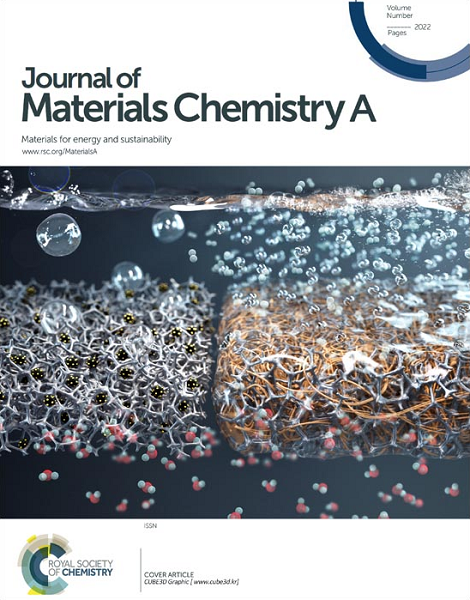Antibacterial sensitive Wearable Biosensor Enabled by Engineered-Metal-Boride-Based Organic Electrochemical Transistor and Hydrogel Microneedle
IF 10.7
2区 材料科学
Q1 CHEMISTRY, PHYSICAL
引用次数: 0
Abstract
Cortisol, an essential stress hormone, plays a crucial role in health monitoring, with wearable sensors providing an efficient non-invasive means for continuous tracking. However, tackling the dual challenges of maintaining high sensitivity over extended monitoring periods and preventing bacterial contamination within wearable devices remains critical. To overcome challenges in detecting low-concentration biomarkers in sweat while mitigating bacterial proliferation, we developed an innovative wearable system integrating hydrogel microneedles (HMN) with silver nanowire/nanoparticle-engineered metal borides (AgNWs@AgNPs@MBene)-based organic electrochemical transistors (OECTs). The device employs polyvinyl alcohol/polyvinyl pyrrolidone (PVA/PVP) hydrogel microneedles to enhance transdermal biomarker extraction from sweat, significantly improving biosensor sensitivity. Experimental validation confirmed that the microneedles effectively penetrated nude mouse skin to facilitate biomarker release, while COMSOL simulations quantitatively analyzed their mechanical stress distribution. Targeting cortisol—a critical adrenal hormone—the device integrates AgNWs@AgNPs-engineered MBene, achieving an ultra-low limit of detection (LOD) of 0.26 pg/mL. Silver nanomaterial-derived antibacterial properties further suppress bacterial growth risks during prolonged wear. In human volunteers and nude mouse models, the wearable system successfully detected exercise-triggered cortisol fluctuations, demonstrating clinical relevance. This study advances the integration of hydrogel microneedles with functionalized two-dimensional materials, offering a roadmap for developing comfortable, sensitive, and infection-resistant health monitoring platform.由工程金属-硼化物基有机电化学晶体管和水凝胶微针实现的抗菌敏感可穿戴生物传感器
皮质醇是一种重要的应激激素,在健康监测中起着至关重要的作用,可穿戴传感器为持续跟踪提供了一种有效的非侵入性手段。然而,解决在长时间监测期间保持高灵敏度和防止可穿戴设备内细菌污染的双重挑战仍然至关重要。为了克服检测汗液中低浓度生物标志物的挑战,同时减轻细菌繁殖,我们开发了一种创新的可穿戴系统,将水凝胶微针(HMN)与基于银纳米线/纳米颗粒工程金属硼化物(AgNWs@AgNPs@MBene)的有机电化学晶体管(OECTs)集成在一起。该装置采用聚乙烯醇/聚乙烯醇吡咯烷酮(PVA/PVP)水凝胶微针,增强了汗液中透皮生物标志物的提取,显著提高了生物传感器的灵敏度。实验验证证实微针能有效穿透裸鼠皮肤,促进生物标志物的释放,COMSOL模拟定量分析了微针的机械应力分布。针对皮质醇(一种关键的肾上腺激素),该设备集成了AgNWs@AgNPs-engineered MBene,实现了0.26 pg/mL的超低检测限(LOD)。银纳米材料衍生的抗菌特性进一步抑制了长时间磨损过程中细菌生长的风险。在人类志愿者和裸鼠模型中,可穿戴系统成功检测到运动引发的皮质醇波动,证明了临床相关性。本研究推进了水凝胶微针与功能化二维材料的集成,为开发舒适、灵敏、抗感染的健康监测平台提供了路线图。
本文章由计算机程序翻译,如有差异,请以英文原文为准。
求助全文
约1分钟内获得全文
求助全文
来源期刊

Journal of Materials Chemistry A
CHEMISTRY, PHYSICAL-ENERGY & FUELS
CiteScore
19.50
自引率
5.00%
发文量
1892
审稿时长
1.5 months
期刊介绍:
The Journal of Materials Chemistry A, B & C covers a wide range of high-quality studies in the field of materials chemistry, with each section focusing on specific applications of the materials studied. Journal of Materials Chemistry A emphasizes applications in energy and sustainability, including topics such as artificial photosynthesis, batteries, and fuel cells. Journal of Materials Chemistry B focuses on applications in biology and medicine, while Journal of Materials Chemistry C covers applications in optical, magnetic, and electronic devices. Example topic areas within the scope of Journal of Materials Chemistry A include catalysis, green/sustainable materials, sensors, and water treatment, among others.
 求助内容:
求助内容: 应助结果提醒方式:
应助结果提醒方式:


